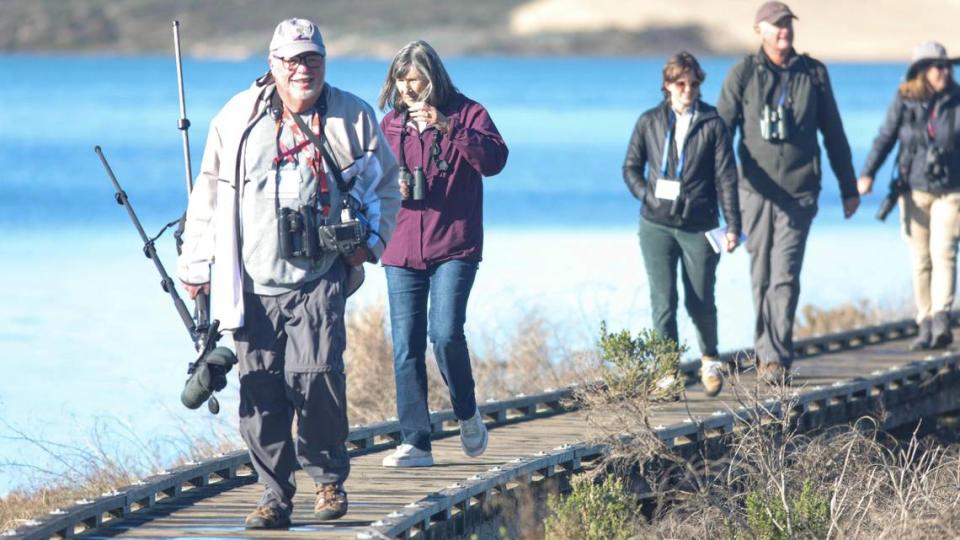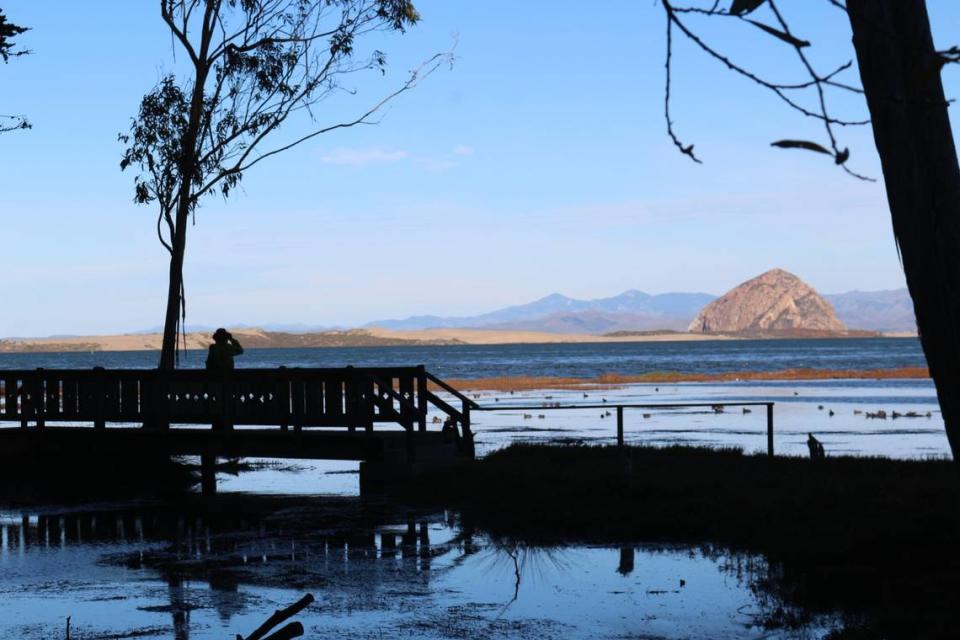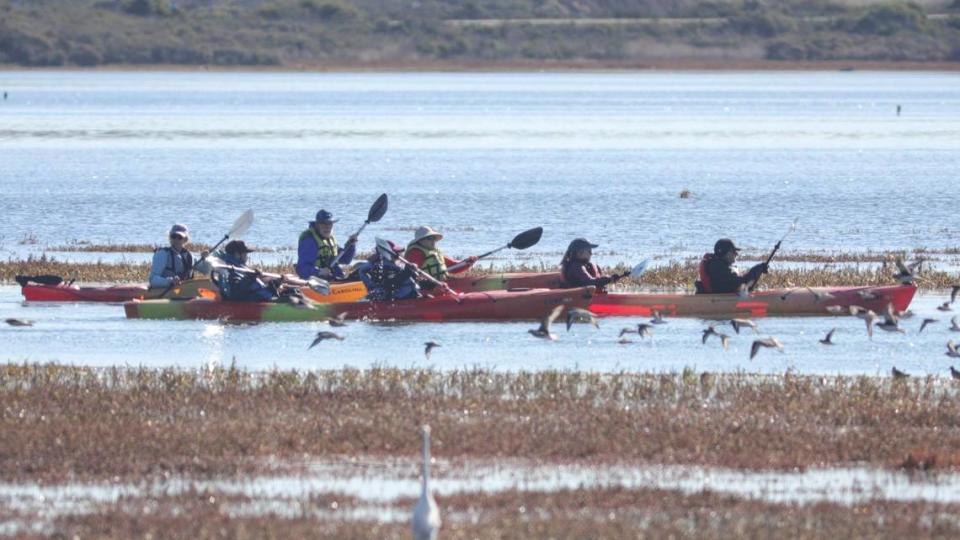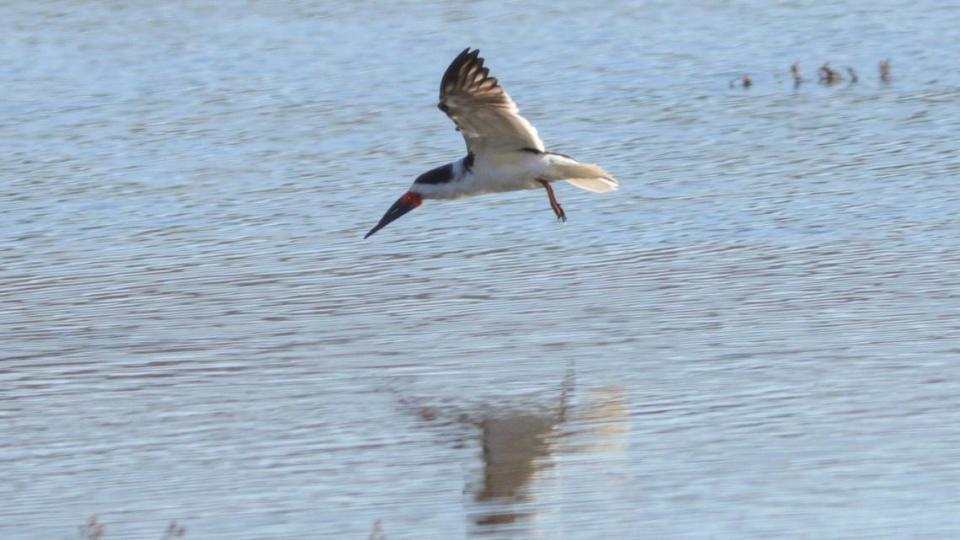Rare sightings, smaller flocks: How climate change is impacting Morro Bay’s beloved birds
On a clear, sunny Thursday morning, about a dozen people stood on the Morro Bay State Park Boardwalk, craning their necks and peering through binoculars in hopes of catching a glimpse of the bird.
The bird in question, a black skimmer, stood on the estuary’s shoreline, seemingly unamused by the prying humans. His characteristic long orange-and-black bill was tucked neatly into his feathers while other shorebirds and waterfowl swam and waddled around him.
“He’s quite unusual for this area,” said Jon Dunn to the group of birders, who were participating in a guided bird walk during the Morro Bay Bird Festival on Jan. 11.
Dunn, a renowned birder and author of the National Geographic Field Guide to the Birds of North America, said the black skimmer typically doesn’t venture as far north as Morro Bay in the winter.
The rare spotting sparked a crackle of excitement among the birders accompanying Dunn for the walk in the state park.
That excitement was further fueled when the group spotted two bald eagles perched in the estuary not too far from the black skimmer. American white pelicans, egrets, willets, avocets, Canada geese, greater scaup, Say’s phoebe, Cooper’s hawk and cormorants were just a few of the more than 50 species spotted in the estuary by the birders during the two-hour walk.

“Morro Bay is just such a special place for birds,” said Robbie Revel, an organizer of the Morro Bay Bird Festival. “Thousands and thousands and thousands of birds are here in the winter.”
The Morro Bay Bird Festival attracted more than 700 people from Jan. 11 through Jan. 15 to learn about and experience the more than 200 bird species in the estuary. Educational opportunities for people of all ages ranged from interactive bird walks, nature journaling classes, photography lessons and field trips around San Luis Obispo County.
During his Thursday morning bird walk, Dunn advised participants to not just focus on the birds but notice their surroundings.
“Always try to put the bird into context,” he said to the group. “Learn what the trees are, what the bushes are, why the birds are there and what they’re doing there.”
Such observations could help lend birders a deeper viewpoint into how birds are impacted by their habitat and the many stressors that come with human involvement, Dunn said.
Even carefully protected environments such as Morro Bay are not immune to human-caused climate change from excessive emissions of fossil fuels — and such change has impacted the thousands of birds that visit the area to feed or breed.
How environmentalists, community protected Morro Bay estuary
In the Morro Bay estuary, long-time birders and environmental advocates have noticed shifts in the birds and habitat over the years.
“If birds are having trouble, we know there’s something wrong,” said Judy Neuhauser, president of the Morro Coast Audubon Society.

In the 1980s and 1990s, advocates in the community worried about Morro Bay filling in from excess sediment washing in through creeks dredged and channelized by farmers in the watershed.
“The concern now is that it isn’t filling in fast enough with sea level rise,” Neuhauser said.
Sea levels have risen at Port San Luis just a few miles south of Morro Bay by an average of almost 3 inches since 1945, according to data by the National Oceanic and Atmospheric Administration. Models by the United States Geological Survey show that sea level rise — expected to rise exponentially in the coming decades — could cause the salt marshes in Morro Bay to be at least partially swallowed by the sea.
Estuaries provide key habitats for birds, fish, invertebrates and mammals because of their unique mix of salt and fresh water. Creeks bring fresh water into the bay which blends with the ocean’s salty water, creating areas where plants that can live off the mixture thrive.
Other estuaries throughout the state have seen massive developments that have filled in or scraped away naturally occurring salt marshes or mud flats. The result is channelized, or concrete and levee-lined bays, such as San Francisco Bay or Mission Bay, where millions of dollars are now being directed toward restoration efforts.
Morro Bay has been carefully protected over decades of work by community members. The result is a habitat that has maintained much of its natural state.
“This estuary is one of the few functioning estuaries on the West Coast,” Neuhauser said. “Without the mud flats and salt marshes here, the birds wouldn’t be here.”
Maintaining the health of the Morro Bay estuary is a task handled community-wide. The Morro Bay National Estuary Program, formed in 1995, has coordinated countless research efforts to monitor its conditions and find where people may be causing problems for the natural environment.
The organization does much of its work in coordination with Cal Poly in San Luis Obispo, along with a host of other environmental nonprofits in the region.

Disappearance of Morro Bay eelgrass impacted brant geese population
When eelgrass — a long, green seagrass that provides food and habitat for species in the bay — nearly completely disappeared from Morro Bay in the early 2010s for reasons not completely understood, brant geese hunters poured donations and volunteer hours into helping the estuary program restore the plant.
“We noticed there was a problem and we tried to do something about it,” said Ed Miller, vice president of the Black Brant Group, Inc., a nonprofit corporation whose members hunt the geese and donate money to research and habitat conservation efforts around North America. “You can’t hunt if there’s nothing to hunt.”
Brant geese migrate from Alaska each winter to estuaries such as Morro Bay to eat eelgrass. When the eelgrass disappeared, so did, in large part, the brant geese, according to data from the Morro Coast Audubon Society.
Previously, upwards of 3,500 brant geese could be spotted in the estuary by volunteer Morro Coast Audubon Society counters during annual winter tallies. Between 2012 and 2019, fewer than 600 were spotted each winter in the estuary, according to the Morro Coast Audubon Society’s data.
Since the resurgence in eelgrass coverage in Morro Bay — about 500 acres mapped in fall 2021, up from a low of 13 acres in fall 2017 — the brant geese have also seemed to return, although nowhere close to the flocks seen before the eelgrass dieoff.
New species may be coming to Morro Bay due to global climate change, habitat destruction
The evolving story of the brant goose is just one of many that researchers and birders have observed at Morro Bay.
Global climate change and local conditions in Morro Bay impacted by shifts in local development, agriculture, weather events and conservation efforts have often created subtle effects.
“We see some more rarities, birds that weren’t ever spotted here before,” Revel said. “Birds that are likely out of their range are coming to Morro Bay to escape habitat destruction or because winters have gotten too hot where they used to go.”
One example Revel gave was the yellow-crowned night heron, which has been spotted in the Morro Bay estuary in recent years.
The species may be venturing out of its normal range in the southeastern portions of the United States and western Mexico regions to escape severe spring heat waves and urbanization, according to the National Audubon Society’s field guide, which has been updated to include the studied effects of climate change on bird species.
Another example was the black skimmer spotted by Dunn’s bird-watching group on Thursday: Black skimmers may be shifting their natural range to escape spring heat waves, urbanization and sea level rise, according to the National Audubon Society.
One way people can help habitats such as the Morro Bay estuary survive is by educating themselves, Neuhauser said.
For example, going on habitat walks with the Morro Coast Audubon Society can help the public better understand why areas around the estuary are so important for bird survival, she said.
“We can’t destroy the ecological foundation that civilization is based on,” Neuhauser said. “Protecting these areas starts with rebuilding ecological literacy so people understand what there is to protect.”

